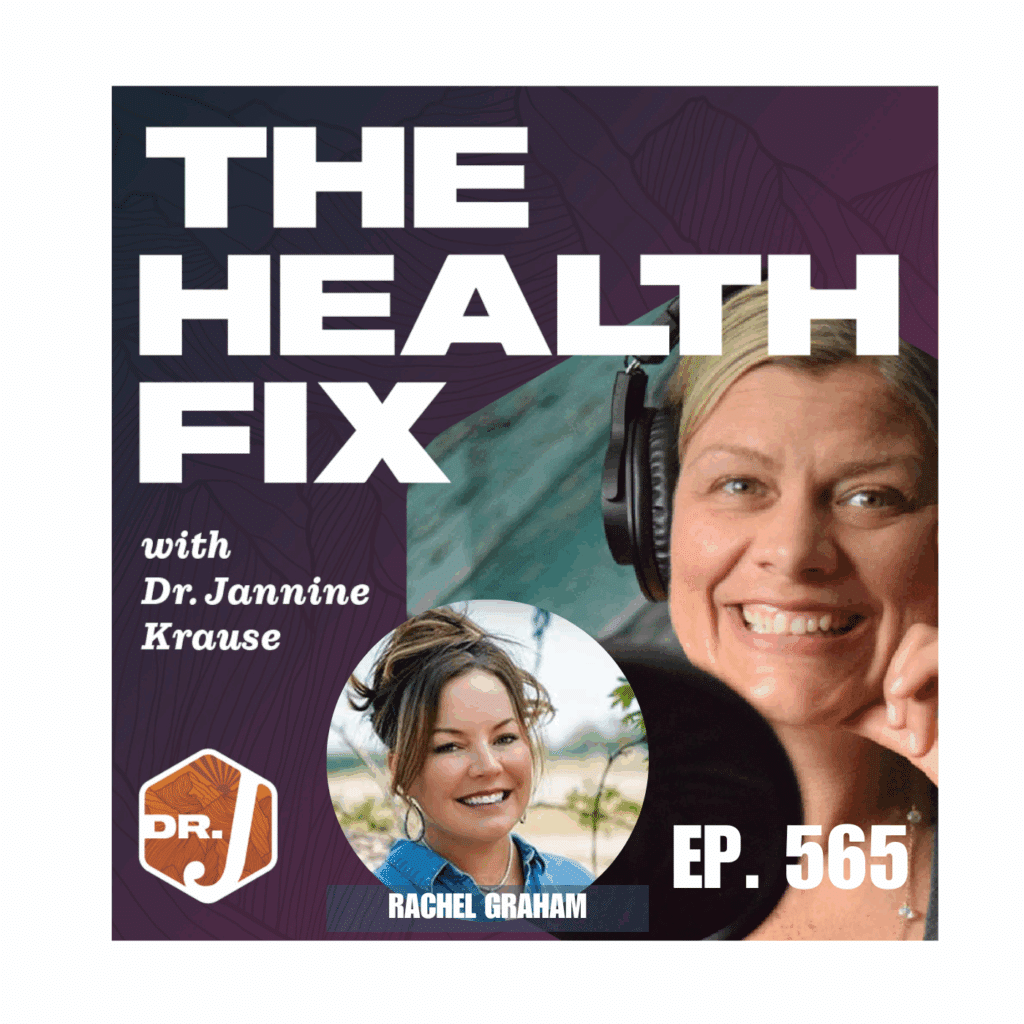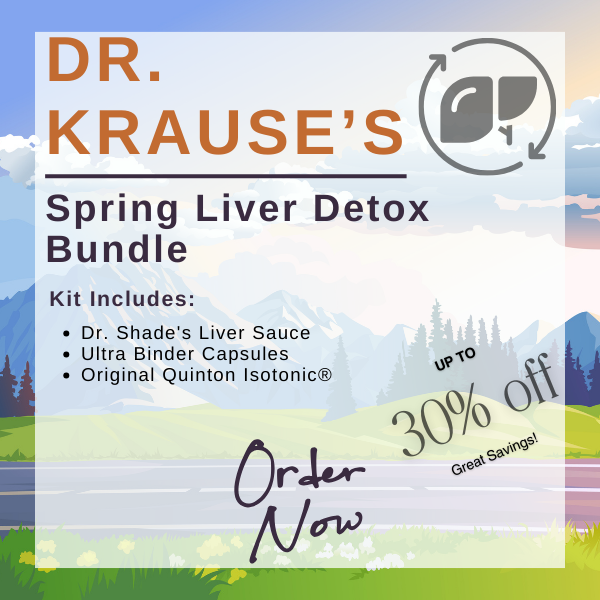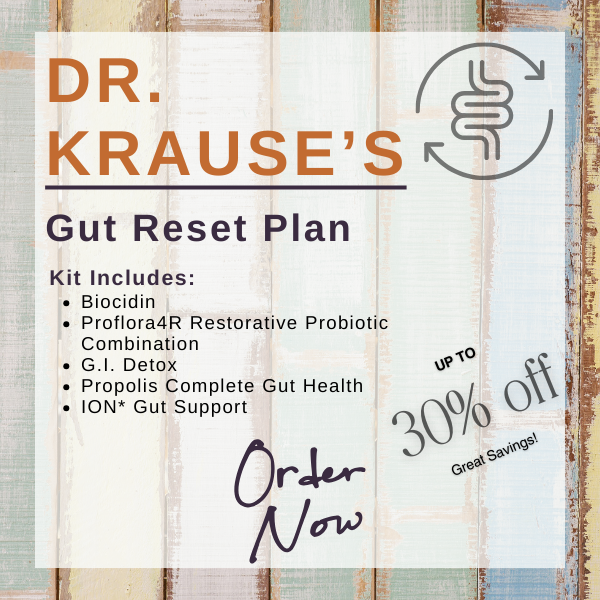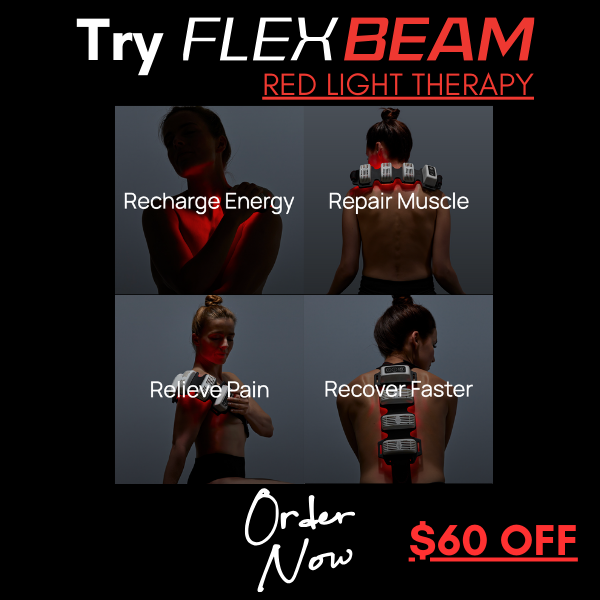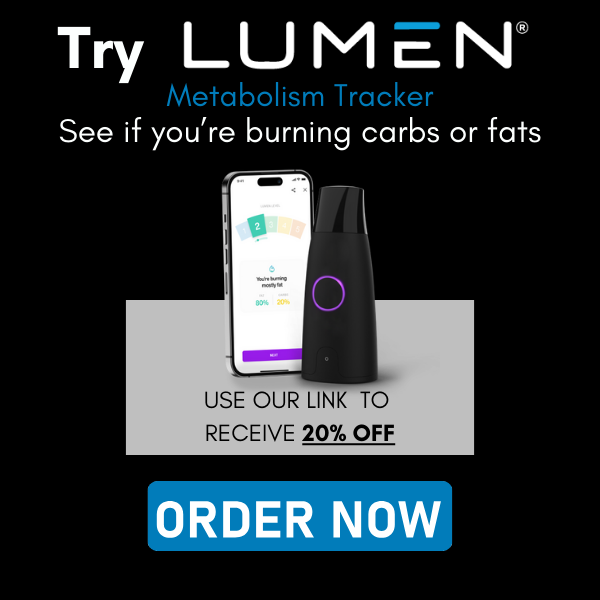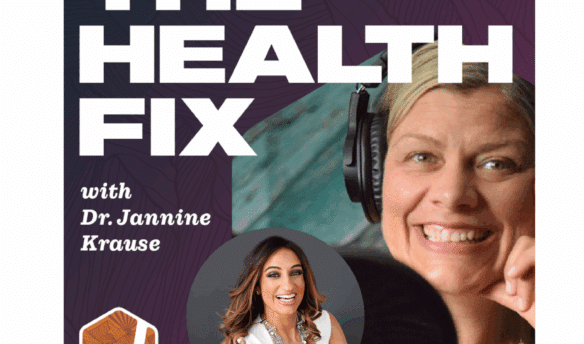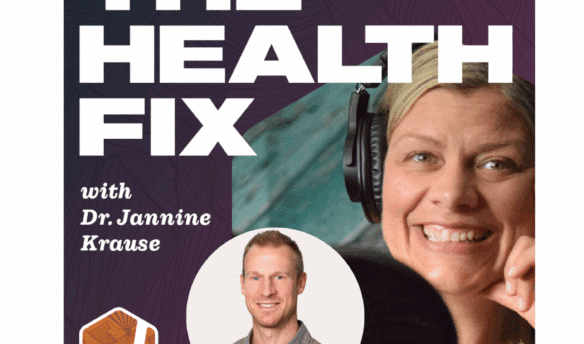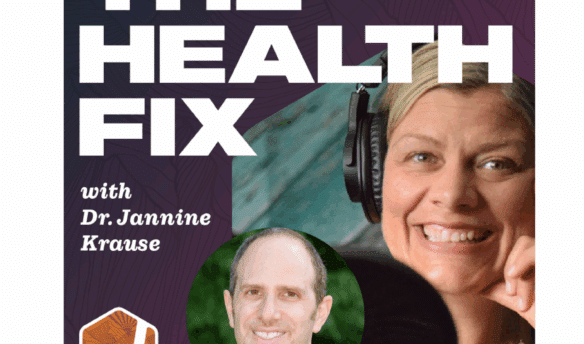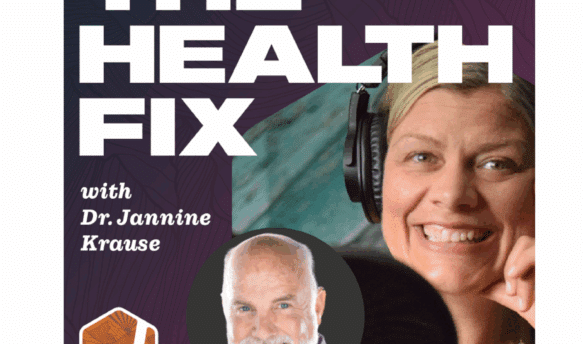Wine, sugar, shopping, scrolling, chips, porn, and even exercise — these aren’t just habits. For many over 40, they become coping mechanisms to deal with unprocessed emotional pain.
In this powerful and eye-opening episode, Dr. Jannine Krause sits down with Rachel Graham, CEO and Co-founder of Healing Springs Ranch, in Tioga, Texas, to explore the often overlooked world of process addictions — and why they commonly emerge or worsen in midlife.
Dr. Krause’s Protocols
Instructions Included
Traveling soon? Looking to detox or reset your gut? Try one of Dr. Krause’s Fullscript plans.
You’ll learn:
✅ What process addictions actually are — and how they differ from substance abuse
✅ Why midlife events like divorce, empty nesting, and hormone shifts (hello, estradiol and testosterone crashes) can spike addictive behaviors
✅ Why sugar cravings aren’t just about willpower — and why even health pros like Dr. Krause aren’t immune
✅ The crucial role of family involvement in the healing process
✅ Why treating addictions separately often fails — and what it takes to heal the root cause: emotional pain
✅ How to stop feeling ashamed — and start getting curious about your behavior
Dr. Krause shares her own story of feeling out of control with chips and chocolate — and what she learned about the real drivers of compulsive habits.
If you’ve ever felt like you’re “better than this” but still find yourself reaching for things to numb or distract — this episode is for you.
🔗 Listen now and take the first step toward understanding what your habits are trying to tell you.
🎯 Mentioned in This Episode:
- Healing Springs Ranch → https://healingspringsranch.com
Our Partners
Podcast Transcript
Chapters
00:00 Introduction to Addiction Treatment Challenges
05:47 Understanding the Roots of Addiction
07:22 The Spectrum of Addictions
09:08 The Role of Family in Recovery
11:02 Innovative Treatment Modalities
16:02 Exploring Unique Therapeutic Approaches
22:51 Emotional Release and Healing
25:47 Creating a Safe Space for Expression
28:31 Preparing for Treatment: What to Consider
31:59 Navigating Scams in the Treatment Industry
34:57 Success Stories: Transformations Through Treatment
39:07 Innovations in Addiction Treatment
43:28 Expanding Support Beyond Treatment
45:20 Outro THFP 2022.mp3
Jannine Krause (00:01.206)
Rachel Graham, welcome to the Health Fix Podcast.
Rachel Graham (00:04.457)
Thanks Janine, I’m so excited to be here, thank you for asking me.
Jannine Krause (00:08.962)
Well, you know, in just our conversation before hitting record, I’m like, you know, what you guys are doing is so important and such a unique aspect when it comes to helping folks with addictions that I was like, we have to we have to share this information. So, of course, I always like to start podcasts out with, know, that that background in terms of you saw what was going on in the adult glorified babysitting industry of
addictions treatment, which is what I do. You know, I’ll be honest. It’s kind of what I’ve seen for a lot of folks and why when I do recommend facilities, I’m very nitpicky because I basically see the people kicking back in bonbons. And so in your own experience, you notice there were some serious issues going on with the facilities and give us your backstory here. What did you discover and what are you on a mission to help change?
Rachel Graham (01:05.107)
Thank you, yes, you are absolutely correct. I had a family member that struggled with addiction and he was in and out of three different places and it was one of those types of experiences where there wasn’t robust programming. I don’t know that there was any focus on really getting to any underlying issues and so as a result, I was pretty upset and we spent a lot of money for that and I decided that
I could go two routes. I could go down a punitive route or I could go out and hang a shingle out and build a better mousetrap. So my focus was to do just that and create a program that is not just centered around addiction and addictive patterns. It’s really about understanding self. And so I jokingly say, know, we’re the Ivy League of treatment facilities where you get a PhD in yourself.
And so our core foundational element is getting to the why. We all know the what, but let’s get to the why. Because if you don’t get to the why, when they leave treatment and they’re outside of that controlled environment, their likely, their opportunity for relapse increases.
Jannine Krause (02:16.161)
Yeah, absolutely, I’ve seen it over and over again. And here’s the thing, and something we definitely talked about earlier and wanna highlight is the stigma. Because a lot of folks are thinking addictions, they’re thinking alcohol, drugs. They’re not thinking necessarily about food, they’re not thinking necessarily about gambling, although we see a little bit more press with gambling addictions, shopping addictions, a lot of folks don’t think about that. But at the root here is it’s all a similar pain. And I know you have your four essential pillars that you talk about.
Share with us this unique pain pattern that every addiction kind of has a root in.
Rachel Graham (02:52.393)
Yeah, well, I’m glad you teed this up. Most people don’t understand that there are substance use addiction and then there’s process addictions.
And so substance use is what we traditionally think of drugs, alcohol, those types of things where we’re inducing some sort of substance into the body. But process addictions are any behavior that we repeatedly do that leads to either financial problems, emotional problems, health problems, legal problems, all of those things. And so all of them, whether it’s a substance or it’s a process is a way of medicating pain. And that’s the piece that most people don’t understand. It’s just a different drug.
choice if you do cocaine and I’m a shopping person we we’re both medicating some sort of pain and so I often tell people that the same part of the brain here the prefrontal cortex that manages physical pain manages emotional pain and most of us can understand physical pain you cut your arm or you pull your neck or whatever you kind of know what to do at that point but most of us don’t understand emotional pain and how to to alleviate that
in a healthy way. So we turn to these behaviors because they make us feel good if only for a few minutes. And that’s the dopamine piece that we’re getting.
That’s the piece of understanding all of this is that we’re all the same. You we all breathe oxygen. We all have belly buttons. We bleed red and we all have pain and we all have traumatic events in our lifetime. And what may be traumatic to you may not be traumatic to me. And at the core of addictive patterns is some sort of trauma that you have to get to and address and alleviate for the individual for them to go on and be successful.
Jannine Krause (04:40.534)
It makes perfect sense. It makes perfect sense. And one of the big things that I notice, especially in this timeframe that I am in life with, with being in perimenopause and a lot of my clients going through perimenopause and menopause are hormones and the drop in dopamine related to hormone shifts and especially estradiol and estrogens going down. I have a lot of women that they’re like, I thought I dealt with my binge eating. I thought I dealt with this or that. And it seems like it’s coming back up.
Rachel Graham (04:54.579)
Mm-hmm.
Jannine Krause (05:08.942)
Do you tend to see that there’s any particular times in life, whether it’s a new trauma or something like that, might bring this up for folks?
Rachel Graham (05:16.349)
Mm-hmm. Yeah, and it could intensify the pain. So maybe you’ve had some childhood trauma and maybe it was from a parent, the abuse was from a parent, and then later on the parent dies. And so you kind of open up some of these things and maybe there were things that were left unsaid, things that you would like to have cleared with them, whatever it may be. And so it can trigger a response to then tie you back to the emotions that you’re stuffing from that childhood piece. So we see that.
A lot.
We see a lot and there’s also situations where if we were to send our client, we call them clients, not patients, cause it’s about the client experience. If we sent our clients back home and we weren’t doing anything to help support the family, their chances of relapse go up much higher. So we’ve created a program where we bring the family along and help the family understand what their loved one’s going through and look at their own family dynamics. You know, I tell the family members, you’re not off the hook.
Jannine Krause (05:53.934)
Mm-hmm.
Rachel Graham (06:16.68)
when you put someone in treatment. You’ve got to do your own work and your recovery looks different than theirs. But there’s work that needs to be done by all if you want to grow as a family or whoever the support group is. If it’s friends, whatever it may be. So we do that for the family so that they can get engaged and involved and also get the benefit of a lot of education to help them.
Jannine Krause (06:41.144)
Yeah, you mentioned monthly family intensive. You mentioned the BOM program as well that you’re offering, which is Be a Loving Mirror. I don’t hear about the family being involved. It seems like more often than not, it’s just the individual that’s being focused on. I honestly have not heard that.
Rachel Graham (07:01.193)
And it’s unfortunate because I was a family member and you’re sitting out there with a loved one in treatment and you don’t know what they’re doing. You don’t know what’s going on. You’re wondering. And the reality of it is that’s a good time for the family members to do their work. And so the Balm program, we actually enroll the families in that and it’s a very robust online educational system where there’s groups and there’s books, recommendations, there’s stuff to read, videos, the whole thing. And so the family can
can do that at their leisure from home. They can log in and manage that. Then we also have weekly family calls where the family members of the folks that are currently in treatment come where they can ask questions, air their concerns, support each other. Cause that’s a big thing that happens. We find that there’s friendships that forge cause they’re supporting each other and they’ve had a similar experience. So that’s a piece that we wove into it. Then we also have to what you mentioned, the weekend family.
and it’s virtual so that everyone can attend. It’s family intensive weekend and that’s a really great opportunity for the family members to have a safe space to unpack their own stuff and be in an environment where other people are sharing that same vulnerability so it makes it comfortable. And then lastly what we do is we allow the clients, they have some ownership in their treatment plan and so we allow them to, if they want to bring in the family to some of their individual sessions at our facility.
we allow them to do that. So we’re really big proponents of the family member and that’s really probably because I was frustrated with what was happening and I felt like we cannot leave the family members behind.
Jannine Krause (08:44.458)
Absolutely, absolutely. You know, in my almost 20 years of practice, I’ve had some pretty heartbreaking cases where I think if the family was involved, things would have gone a lot better. I remember one particular case with hoarding that just was heartbreaking. And I think a lot of folks don’t realize, you know, hoarding, we don’t think treatment facilities for hoarding. We just don’t, right?
And we don’t think of the family being involved and how to help in that case because a lot of times there’s a lot of family shame. There’s a lot of things that go around with that. I’m mentioning it, one, because it doesn’t get a lot of talk. Two, because I have a family member, not who’s a hoarder, but she is a best friend with a hoarder. And it is just heartbreaking to watch the dynamic and thinking of how…
Rachel Graham (09:24.617)
Mm-hmm.
Jannine Krause (09:37.678)
You said you’re not only allowing family to come in, you’re having friends or the support group. And how important that can be because conditions like that sometimes are hard to really understand why.
Rachel Graham (09:51.955)
And I love that you mentioned hoarding because you’re right, most people don’t think of that. And so what happens if you have a hoarder in the family, everyone wants to be punitive saying, you need to clean up your environment. How can you live like that? All these things that invoke shame. And so…
Jannine Krause (10:06.371)
Mm-hmm.
Rachel Graham (10:07.849)
at the core of addiction is shame. And shame is different than guilt. Guilt is I feel bad for maybe something I said to you, Janine, I need to apologize. Shame is I’m inherently bad and I don’t have a place on this planet. And so when you’re hearing this constant berating of people telling you you should change your environment, how can you do this? It’s gross, your house is gross, whatever it may be, it only reinforces the behavior because then they want to act out more to alleviate the pain.
So if you have someone that’s struggling with hoarding, there’s a there there. You just need to get down to what’s going on underneath that and help them address those issues so that they can break the cycle. We also see generational cycles. That’s not uncommon. So we see where if dad came home and had two scotches after a hard day at work, well then kid came home as an adult child and had two scotches because we learn behaviors by watching those
people that are caregivers or who are responsible for us. So there’s some generational patterns and generational, all kinds of generational behaviors that might be handed down as well as depression, anxiety, all of the other stuff that can run in families that we see.
Jannine Krause (11:22.306)
I definitely know about that. I definitely know about that. Watched my mom binge eat and of course, after some kind of fight with my dad or some kind of thing that got her flustered. And so then of course, when I got older, what happened? What was my coping mechanism? And yeah, I have been through certain eating disorder programs thinking that was going to solve it. But at the end of the day, yeah.
You got to get the PhD in you to understand where this all comes from and unraveling it. And I would love to really start to talk about the different offerings you have for learning more about yourself because you have a couple of things that I think some people might not have heard about in…
Rachel Graham (12:08.403)
Yeah, no, thank you. We have a robust schedule and I think I mentioned to you that the comment we get sometimes when the clients give us feedback on the exit survey.
is that they wish they had more downtime versus them saying all we had was downtime. Typically in a treatment facility, you see a lot of downtime. So we feel like if you’re gonna give us the gift of your time and resources, we’re gonna make the best use of it while you’re here. So we have a very robust program where we tend to have an educational session in the morning and then an experiential in the afternoon. So we might be talking about anger.
is the emotion of anger and what too much anger is rage that’s not healthy. How do you get back to anger which is a normal emotion that we all have and how do you resolve that? Then we might go to anger management or we call it fit now.
And it’s where they actually throw play balls at the wall and what the therapist and the therapist is provoking some of the things that were triggering them and making them very upset. So they’re actually tying that emotion to a physical release.
And there’s a lot of opportunity for them to heal from being able to connect that in that way. We also have art therapy. So we do that through they, they make art and then we have a clinician that goes through and breaks that down. We do a lot of the other modalities. have 12 step, we have celebrate recovery. We, we have all kinds of different recovery support programs that we introduce clients to because 12 step may work for you and celebrate recovery works for me.
Rachel Graham (13:47.287)
And so we want them to know that there’s other things out there. If something’s not working for you, try something else. So we also, I actually curated a class called Lit. So it’s a play on the term getting lit together. And it’s leaders in training. And so I bring what I believe are the best in class modalities I’ve been exposed to in leadership development. And it’s really kind of a corporate leadership.
Jannine Krause (14:00.344)
You
Rachel Graham (14:11.035)
Opportunity and some of the people are needing to switch jobs. So we’ll work on what do you need to do? some of them maybe are happy in their job, but they want to you level up within their company whatever it may be and some of them are not working they’re not working but they want a purpose so it’s centered around purpose and Finding meaning and some of the rough things that you’ve been through in life and how do you apply that in a healthy way and do some things and Basically look at where you are now and how do I move?
forward because so much of treatment is here’s where you are how did you get here
Jannine Krause (14:45.194)
Mm-hmm, mm-hmm. Absolutely, absolutely unraveling a little bit of that. Now one of the things that I found on your website was psychodrama. And I’m pretty sure a lot of people don’t know necessarily what that means. They might have seen something on Instagram, but it meant completely different. So I’m curious about that. And then brain spotting, I’m familiar, but I’m not sure a lot of folks are familiar with brain spotting. So I’d love to highlight those a little bit so folks can understand what other options are out there for them.
Rachel Graham (15:15.421)
Yeah, yeah. And then one of the other things that I’ll add to that is ETT that we do, which is very different. So I’ll start with ETT. So it’s emotional transformation therapy and it was traditionally used in the autism world. And we brought it into the residential treatment side and
Jannine Krause (15:24.748)
Yeah.
Rachel Graham (15:35.323)
In doing so, it’s actually a very unique modality where it has a color wheel of all different intensity, all different colors with the really, really rich intensity on it. Then what the therapist does, which they have to be specifically trained in this and there’s different levels, they actually walk the individual through and certain colors evoke certain things. And so the idea is that the color, when it comes through your eye, you see the color, but it also impacts neural pathways that also
regulate emotion. So if we can get to that emotional response, then we can work through alleviating that. So most of our clients are blown away. They don’t know what, how it works or whatever. They said, I don’t even need to know how it works, but it works and they feel better. And it’s really helpful with depression, anxiety. And we were published in the, one of the trauma journals for outperforming the anti-anxiety medication and also the antidepressants. So by doing some of these things, we were,
able to our whole program was able to outperform that. As far as psychodrama, psychodrama is actually quite fun. So you have the protagonist, you have somebody
that is going to be featured in the psychodrama and we’re going to act out a particular situation that they went through, traumatic situation. And so they have an opportunity to have their community members, the other clients play different roles in that, the dramatic play, if you will, of reenacting that with a therapist walking you through the pieces. And so it’s powerful. And it’s an element that, you know, really, really helps individuals. And I think most of them
Don’t want to do it when they get there. They’re like, I don’t want to do this But once they do it they said I feel so much better You know, so we do that we do some meditative stuff. We do mindfulness. So that’s a big piece of what we do We actually teach clients how to self-regulate through breathing through different types of things because the goal for us is To not have people on medicine if they don’t need to be on it if they need to be on it That’s okay. But the goal would be to to try
Rachel Graham (17:45.731)
other things first before we go to uphill to help us.
And so one of the beauties of being in residential treatment is that we can switch meds and play with things and find the right thing for the individual because they get to participate in that too and say, you know, this is not making me feel good. I need something different. And so our doctors can then switch that up and they’re monitored and they fill out forms in the morning. So they’re monitored on the medication, but they fill out forms in the morning so we can see kind of how they slept. So sleep is a big part of our program.
We really work on eating, and one of the things you mentioned, eating disorders, it is not uncommon for the eating disordered people or disordered eating patterns folks to come in and have some trepidation about that. So we curate even special foods and special eating protocols for those individuals as well. So we have a ton of different programs and the goal is I’m gonna give you 100 tools in your toolbox when you leave here.
tools don’t work, know that there’s thousands more out there that you can go try and bring them in.
Jannine Krause (18:56.734)
Yeah, I noticed, know, and folks, you can all head over to healingspringsranch.com. There’s a ton of different modalities. I didn’t even list. just picked out the ones that I was like, I’ve never heard of that. You know, a lot of people are starting to talk about somatic experiencing. A lot of folks are trauma-informed trained and now trauma, you know, people are aware of trauma, getting stuck in the body, let’s call it other than that. And folks are really starting to become aware. But I don’t really think…
that at the end of the day, we know that that’s a possibility. But I think the biggest question I always get is how do I get it out of me? And this is where the psychodrama, know, things of that nature come in. Now, do you guys get that comment often? Like, I know I have trauma. How do I fully release it? Yeah.
Rachel Graham (19:42.557)
Yeah, we do. And I love that you’re talking about the somatic piece of that because there is, you think about it. If I’m carrying a bunch of weight around my middle and I’m a 50 year old woman, that’s likely hormones. You can look at me and you can tell kind of that’s likely hormones. So we kind of wear.
And behave the things that are going on in our body. Our body wants to reach homeostasis. And then when it can’t, it has different things that come out. And so we talk about suppression of emotions. And so most of the folks that come to us have been suppressing and pushing down the emotions to where it gets here. And there’s just no other place for it to go. They’re filled with it and it explodes in some kind of way that is often the catalyst for them getting into treatment. And so…
One of the things that we really encourage people to do is, then Joseph Campbell has a brilliant phrase, it says, the cave you fear the most holds the treasure you seek.
And so the idea is you’re going to have to go into these deep caverns and it might be scary and you might be exploring different emotions that you’ve not felt before or maybe not even understand the emotion that’s coming out, but you have to go there and we create the safe space for them to go there and help them understand what that is. And we have clients that kind of operate from a head space sometimes and some that are more feelers, the head space people, we have to sometimes get them out of their head and get them into an emotional space so that they can understand because they’ve just
been intellectualizing it, you know, away and it doesn’t work. You know, for us women, by the time we’re about 40, if we’ve been stuffing it, it comes out in very weird behaviors. It might be different things that we do to self-destructive things, or it might be self-esteem issues, whatever it might be. And then for men, they can hang on a little longer and it comes out in their 50s and then we call it a midlife crisis, you know? But it’s really just a situation where now I’m going to be forced to reconcile with these feelings.
Rachel Graham (21:41.019)
because they don’t go away. And you can actually help someone with the psychological aspects and the physiological stuff. So we use things like yoga and mindfulness, deep breathing, things like that to help people learn how to regulate and how to work through and let this out. Let it come out.
Jannine Krause (22:02.414)
I think that’s a fear a lot of people do have is how it’s gonna come out, what’s gonna happen. I’ve had people come in afraid to do acupuncture with me because they’re like, I’m afraid I’m gonna start crying and never stop. you know, it’s, I get it, I get it. There’s real fears around what happens when I go to a place for 30 plus days. You know, how is this gonna go? Give us a little, like take us inside, take us, know, what someone might experience if they are.
working with some fears and working with really being able to to express themselves, what kind of things would you guys do to help have someone feel more comfortable expressing themselves and things of that nature?
Rachel Graham (22:45.949)
Mm-hmm, thank you. We do the typical process groups, so that’s where we actually work with the individuals in group setting. And so what we find is sometimes when you’re sharing your situation in a group, someone else can connect to your story. They may have had a similar story, something about your story makes them want to connect, and then you don’t feel as alone in all of that.
Jannine Krause (23:09.836)
Mm-hmm.
Rachel Graham (23:10.865)
And so we have group programs. even separate genders sometimes. So we can talk about male issues and separate from female issues.
And so we do that as well. And then they go to individual therapy. So they have an individual therapist that they work with several times a week. And they actually have the opportunity to start drilling down into all these things. But a lot of the exercises we do in the educational sessions are to provoke kind of getting them thinking about what is it that I need to address when I’m here. And I think one of the things that we’ve had people come back a second time and they told me this is kind of interesting and it’s important for someone to know when you’re going to treat.
When I asked them what do you think got you into a situation that you know you’re now back here and they said it really is about the fact that I didn’t unpack everything the first time and I’m here I’m ready to unpack it and I’m gonna go the distance because I was scared to go the distance and so they’ll unpack it at that point in time and I tell them you know if you don’t unpack everything in this environment it becomes that cancer that becomes metastatic and so
Jannine Krause (24:10.68)
Thank you.
Rachel Graham (24:21.227)
So that’s typically, I think, people are struggling and come back when that happens, it’s because of that. And so I encourage people, when you do go in to treatment, is go there. It’s a safe place to go there. You can’t surprise us with any of your stories. We’ve heard all kinds of challenging stories. There’s some people, I can’t believe they’re still alive, you know, when I hear their stories. And you know, you can’t help but just feel compassion for these individuals.
Jannine Krause (24:52.204)
Makes sense, makes sense. I think for a lot of folks, one of the other things, and this is also for me asking because of being a provider, what kind of things might someone think about before going into a treatment facility to help maybe expedite the processes that happen while in, or to prepare them for getting into?
a facility, what kind of things might you think that would be beneficial if someone’s listening that’s like, okay, I’m scared, I wanna do it, I’m not really sure if I’m at the place right now, what kind of things could you encourage them to work with?
Rachel Graham (25:31.657)
Yeah, I think it’s inventorying your life. You know, let’s look at how happy am I? When you look in the mirror, are you pleased with the situation or the outcomes or whatever you’ve been going through? And so identifying the areas that you’re not.
happy with, you know, and oftentimes that’s already identified for you if it’s a DWI and you’re arrested, whatever it may be. identifying some of the pain points, but I think also identifying who’s going to be your support system and who is healthy enough, because what you don’t want to do, if you’re in a toxic relationship, you don’t want to go to treatment and come right back to that toxic relationship. So it’s identifying who’s, you know, on your team, so to speak, and who’s going to be involved and let them know you
want them involved in their treatment and your treatment and so they can actually be prepared and do some of the work and we’ll encourage them to do some of the work too with the BOM and some of the other programs that we do for the family members. But I think there needs to be a readiness and sometimes people say I’m gonna put so-and-so in treatment.
They have to be ready. You cannot force someone to do something they don’t want to do. But what you can do, and as a family member, is hold healthy boundaries. So if you’ve been enabling this person by giving them money and they’re using it to buy alcohol, you you cut off the supply. You’re not going to be providing money anymore. So oftentimes with an addict, you see an enabler. There’s someone playing that role in their life that’s actually enabling that behavior. And so we try to help in the family session that might
who’s the enabler and why are you doing it? When people enable, it’s because of their own pain. Most people don’t associate that. They think they’re just being nice or they’re worried about their child or their spouse or whatever and that’s true. But they’re doing it because there’s something within them that needs to be looked at. So I think as a family member, if you want to encourage someone to go to treatment, you can start holding healthy boundaries and encourage them to go and encourage them to do a tour. Go do a tour of the facility. We do that all the time.
Rachel Graham (27:33.707)
Get familiar with the program, call their admissions office, ask them what all they do, what does a typical schedule look like? And let them give you a schedule and tell you more about the program so that it’s not so scary coming in. And I think you come in with a mindset of I’m here to work, I’m ready, let’s get this done, I don’t ever want to have to do it again, and I want to go in and live a happy, healthy life. If you come in with that mindset, you’re gonna get exactly what you’re looking for. I tell the clients you’re gonna get what you put in to the program. So you come in and you do it, you know,
in a way that’s not fully unpacking everything, then yeah, you’re gonna have some things later on that are gonna creep back up. We have an alumni group too, that’s very busy. They do some activities, we do different things and they get together outside of Healing Springs. And so the alumni support each other as well. So they might call each other if they’re going through something difficult and another person might be there for you to help you talk through that and whatever the situation may be. And then we have an alumnus.
call every week so if they want to get on the call with one of our folks, our staff members, they can get some help and support on that phone call as well.
Jannine Krause (28:43.342)
That’s really neat. I saw that. thought that was pretty cool that you, know, a lot of places you leave and you’re done, right? And, you know, that’s all you get. And to be able to do that, that’s huge. Now, one of the things we talked about before you hit record is the situation where there’s some scammers out there who are impeding folks ability to get to quality care and also like directing people to the places that they get kickbacks from.
Let’s talk a little bit about that because I think this is huge and also such an important topic because when you’re vulnerable already and then you’ve got this on top of it, man, not good, not good.
Rachel Graham (29:27.913)
Thank you for opening up the door for this conversation because I don’t think people know what’s happening in the industry at times.
We were alerted to this because we had a mom who was trying to get her son into treatment and she called and finally got through to us and talked about how obnoxious and rude our intake person was. And I said, who did you talk to? And she said, so-and-so. And I said, we don’t have anyone by that name. So I said, what number did you call? So she gave me this number. She said, when I searched you online, it was the first number. I saw the picture of the facility and it was a number. said to call it. So I did the same thing she did. And I,
called the number and it wasn’t us. And so I had to start putting together what was happening. so basically there are marketing companies out there that have treatment facilities that pay to play and those facilities get leads from the call center fed to them so that they can have admissions. And so what we notice is they use the likeness of other facilities to attract people in. And it’s kind of a bait and switch. You come in, you might say you want to go to healing Springs ranch and they tell you, you’re a better
Jannine Krause (30:08.877)
Wow.
Rachel Graham (30:36.171)
for XYZ treatment facility. And so these folks call in, they’re confused. They don’t understand I was calling Healing Springs. They also get misinformation about the different treatments facilities are asking about. And so I was appalled. I could not believe how systemic that was. And so what I’m encouraging family members and individuals to do is when you call that facility, call from their website. Don’t search it because when you do that, the pay-per-click ads are at the top and those are the folks that are scamming.
everybody and so the FTC has taken a look at it now and they launched a lawsuit in January against some of the folks that are doing this so I’m happy to see them cleaning up what I would say is probably a dirty part of the industry.
Jannine Krause (31:20.65)
It’s just, it just, ugh. You know, we have so much scams against vulnerable populations and folks who are just looking for help. it just chaps my hide. It just really does. man.
Rachel Graham (31:34.909)
We had a guy that was at a .387 blood alcohol level, which four is catastrophic, can lead to death. And he was trying to get into our treatment facility and they Google searched, they were headed there, they Google searched and they called that number and they sent him to another treatment facility. And so…
It’s scary what they’re doing and I feel like what’s gonna have to happen? Someone’s gonna have to die for people to finally get it. So I’m so excited that the FTC has taken an approach to start going after these individuals because you’re right, when you’re looking for a treatment facility, it’s not because everything’s going great, you’re in crisis. And these companies are taking advantage of people in one of their most vulnerable moments where they’re just needing help and they’re relying on you to be the subject matter expert on where your loved one needs to
go and make sure that they get to the place safely.
Jannine Krause (32:30.104)
That’s just horrible. That’s just horrible. Well, let’s turn it around and talk a little bit about maybe a case or two of your favorite cases that have come through your door and some of the like greatest successes you’ve seen. Because I think for folks listening right now, they might be thinking, OK, maybe there’s someone in their life. Maybe it’s them themselves. know, what kind of success stories do you have? I know you have some on the site and I know you’ve got lots of them, but
Maybe some that resonated with you.
Rachel Graham (33:02.131)
think one that stands out to me is we had someone that was a repeat, not to us, but had been in and out of many different treatment facilities. And he came to us and he had this stack of papers that he carried around every day like Linus’s blanket. And I said, what’s in that stack of paper? And he said, it’s my life.
and don’t touch it. You don’t want me to touch it. And so we got him to a place where I said, okay, let’s look at the stack and let’s organize it. So we did, and there was past due bills and you know, all the stuff that none of us want to look at that brings us down. And so we got it organized in a system. And so I said, well, are you interested in going back to college? You know, you have some college, what do you want to do? And he said to me, I can’t go back to college. I failed out of so many classes. It’s just going to take me too long. I’m so far behind, blah, blah, blah, blah, blah. And I
said, let’s call the university. So we called the university. He’s like 12 credits short of a degree. So I said him, you do not fumble the ball five yards from goal line. So we got him back into school and he decided to be an Uber driver so that he could have some accountability in staying sober. And he went on and finished school. Then not only did he do that, but he went to law school and he’s completed law school and he’s now an attorney for people like him.
Jannine Krause (34:19.406)
Wow.
Rachel Graham (34:23.307)
that didn’t have the money to do, you know, to get help when they’re in trouble from their addictive patterns. And so he’s just done a wonderful job in really taking this and letting it empower him and let it be a voice for him to connect with other people. We don’t realize that connection is at the root of addiction too, because when you’re in an addictive cycle, you disconnect. You know, that’s one of the first things you can see in someone if they’ve relapsed is they start disconnecting from everybody they care about.
Another one.
Jannine Krause (34:54.008)
Mm-hmm.
Rachel Graham (34:55.889)
We’ve had gosh, we’ve had so many different ones We we actually had someone who came through our program who the minute I saw him I knew he had that special something that there was something bigger and greater for him to come And so I I gave him a nickname while he was in treatment And so I still call him that to this day But he also went on and became an entrepreneur and is now doing amazing things and is now married and you know, it’s so Amazing when you see marriages that happen
Or babies that were born after the fact and they’re born to healthy parents we put a testimony online on our website two of them actually and one of them is a gentleman who his family’s actually interviewed in the interview where they talked to the dad and the adult son and What the impact was for them and you know, he said I have a daughter in that video He said I have a daughter now who’s never seen her father use and it’s
It’s a great feeling. So there’s so many amazing stories and so many things that I could tell you go on and on. I really feel like there could be a whole TV show on it.
Jannine Krause (36:08.046)
Sure, I’m sure. No, it’s wonderful to hear that. And you know, I definitely always want to end on a positive note because I find it so important for folks to hear that there are successes, there are possibilities and this can happen for you too. You know, it’s one call away, literally. And once you go to the website, guys, though. But you’ve got so much going on. So Healing Springs Ranch.
Com guys just amazing place to to check out and of course, you’ve got some TED talks You’ve got I will put that in the website in a notes there at dr J Krauss indeed calm and you also have a book coming out with short stories about connections So we’re gonna be looking forward to that. What else is on what else is on your plate? What else are you up to? What can we expect, you know from the healing Springs ranch and you guys going forward?
Rachel Graham (37:03.721)
think a couple things. So I spend a lot of time traveling the globe, speaking about this to business leaders predominantly, but sometimes we get the spiritual leaders and political leaders. And I go to these places and speak to educate.
so that people understand what addiction really is, that it’s pain. It’s pain underneath that. And so giving them some tools if they encounter someone or they already know someone in their family that’s struggling, how they might be able to interact with them. That’s something I’m super passionate about. I’ve, you know, like I said, I’ve been on six out of seven continents. I’m not sure that Antarctica, you know, the penguins want to hear what I have to say, but you know, that’s the last one. But then we’re also really focused on innovation. So we’re,
We’re trying to stay ahead of the industry. The industry is very stodgy. And so we’re trying to change that by looking at different things, wearables, different things that people can use where they can start seeing where they’re going to getting dysregulated or where they need to take a step back.
do some breathing work to bring down that anxiousness. So our goal is to continue that. We’re also a teaching facility. So we teach our competitors what we do because we feel like everybody needs to understand good quality treatment. And for me, the full circle moment, and I’ll tell you this, this is, no one really knows this. I’m going to share it on your show is that when the treatment facility that
did so much damage to my family when I saw their clinicians in our program learning from us. I turned to my business partner, I said, that’s the group that is now learning from us. And I said, we won, you know, because it’s just getting people to do good quality work. So.
Rachel Graham (38:53.703)
That’s what you can expect from Healing Springs and I’m excited. full of energy. I’m excited about doing these things and I’m excited about testing modalities with not only our clients but our alums. They want to participate in some of that. So that’s where we’re headed and I can’t be more excited.
Jannine Krause (39:13.282)
I’m excited for you guys. I’m also excited for everyone that, you know, needs some help and is looking for somewhere to go to. Now, of course, I never even mentioned that you guys are in Texas. Let’s give folks a little rundown of like where in the Texas area, because I’m not familiar of, I’m gonna probably say it wrong, Cayuga, Texas. Okay. So tell us where is that and, you know, some of the highlights of the area too for folks.
Rachel Graham (39:32.051)
Tioga, you take care.
Rachel Graham (39:40.571)
Yeah, so we’re about an hour north of the DFW airport, so that’s the main hub that we use.
We transport clients from the airport so if they want to fly in and we’ll go get them and bring them to the facility. But we’re out in a rural area, it’s horse country. So it’s where there’s lots of horse breeders for racing horses, for show horses. And so it’s a very beautiful atmosphere. And so we’re on 80 acres. And so when you come up to our gate and you look out, we have a nine-hole golf course on the front. And then we have several buildings, but we have a big lake that’s stocked with fish.
so that people can fish. And so when you see it, it’s expansive piece of property that you, it’s very peaceful. And so the goal is to get you out of the hubbub of the city life and all the things that are going on and the distractions of that. And let’s put you in this environment where you have some peace, you have beautiful nature, we have some of the most beautiful sunrises and sunsets. We have all kinds of critters that come around. We even have a pet chicken. She came, she showed up one day on our door and she had a little bum foot, her name is Anime.
Anime is now probably a mascot. Anime gets more attention than most human beings do and so she’s an added benefit to coming to us. So it’s just a peaceful place. There’s something about it. It’s called Healing Springs because there are springs that come from West Texas under there and so it really is a healing place and I think that’s something I see in the exit survey with the clients. They said this is a healing place and so we wanted that in the name.
So that’s part of the reason it’s named that.
Jannine Krause (41:18.972)
that’s awesome. That’s awesome. man, sounds lovely. Sounds like a great place to also, you know, rejuvenate yourself. And sometimes I always wonder if there’s a space for folks that, you know, I feel like most of us have certain types of pain we’re working with. And so I always wonder if it’s a space and then you can feel free to answer this. If it’s a space for anybody who’s trying to get a PhD in themselves for overcoming certain.
Rachel Graham (41:46.346)
You’re not the first person ask. Many family members, when they come to the family sessions, they go, what do I need to do to check in? I want to stay here.
And so we’re looking at expanding the product offering, because you’re right. I’m doing CE credits for all kinds of different licensed individuals, and I’m teaching the material that we teach at Healing Springs, I’m teaching it to them to help them in their business. So that’s one way we’re getting it out there, by teaching CEs to realtors and to clinicians and whatnot. But we’re looking at different product lines where we can do that, because we have a lot of folks that are asking for that.
are asking for continued education because they said that felt like I was on hyper warp and then I discharged and I want to keep going in my learning and so we were listening and we’re trying to figure out how to design that because you know all of us could use a lot of that education you don’t necessarily have to be in a catastrophic situation to understand how to apply that and live a healthier life.
Jannine Krause (42:47.726)
Makes sense. Makes sense. Now Rachel, where else can folks find you besides the website Healing Springs Ranch and the TEDxTalks? Are you guys on Instagram? you on LinkedIn? Are you active on any other social media sites?
Rachel Graham (42:58.889)
We’re on Instagram, Facebook, and LinkedIn. We’d love to connect with everyone. We put information out there. We do some supportive stuff. We’re going to start putting some of the video clips out there and different things that we do. So it’s a wonderful place to come get some knowledge and take it with you.
Jannine Krause (43:19.95)
Great work there. I’m inspired. I will definitely be talking to clients about it and I look forward to hearing more good things from you guys and seeing that book at some point here.
Rachel Graham (43:30.227)
I know you’re inspired, I just need to finish it. So now that it’s out there, you put it out there, it has to get done timely. So I’ll get it there and then we can talk about that. That’ll be fun.
Jannine Krause (43:41.102)
Sounds like a plan. Sounds like a plan. Thanks again for coming on Rachel. I appreciate it.
Rachel Graham (43:44.743)
Okay, thank you. I appreciate this opportunity.
Jannine Krause (43:48.694)
Alright.
